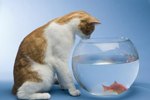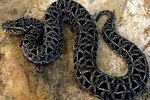
Snakes may have a bad reputation; however, when it comes to their environment, they’re actually quite delicate. They also have a sensitive respiratory system their environment affects. Any sneezing from a pet snake needs to be noted and carefully watched. If it escalates, he needs to see a vet immediately.
Causes
Unsettled dust from cleaning his tank or bedding may cause a snake to sneeze, as well as other airborne irritants. With those ruled out, one of the most common causes of sneezing in reptiles is a respiratory infection. These are usually brought on by his housing temperature being too low, or his environment being too wet or dirty. Stress or improper diet are also factors. Since most snakes only have one fully functioning lung, respiratory infections are a serious medical concern. A veterinarian needs to be seen at the first sign of symptoms.
Symptoms
Depending on the severity of the infection, his sneezing may leave a blood-tinged discharge on the sides of his tank. Along with this, other signs of a respiratory problem include open-mouth breathing, wheezing and bubbling around the mouth or nose. Lethargy and loss of appetite are common. Since snakes can go long periods of time without eating, they may do fine without food as the infection runs its course. However, if there is noticeable weight loss, he will need to be force-fed.
Veterinary Care
In reptiles, most respiratory infections are bacterial, and antibiotics are needed for essential treatment. Left untreated, bacteria may enter the bloodstream and potentially be fatal. Antibiotics are usually given by mouth or injection. Respiratory problems can also be viral, fungal or even parasitic. Treatment will vary depending on diagnoses. Depending on the severity of the snake’s condition, blood work, X-rays or a sample swab from the respiratory tract may be required. A veterinarian can also address any husbandry issues that are contributing to the snake’s poor health.
Aftercare
At home you can help the healing process by making sure the snake’s enclosure is clean, properly lit with ultraviolet B-light and heated to his normal temperature gradient. A humidifier can also help his breathing. The increased heat and humidity loosens mucus. Most exotic veterinarians have a humidifying tank available. One can also be made at home by connecting a well-ventilated plastic tub to a regular humidifier. Ask your vet for instructions on how this is properly constructed, and how often it should be used.
References
Photo Credits
-
Jupiterimages/Goodshoot/Getty Images
Writer Bio
Slone Wayking worked as a professional in the veterinary field for 20 years. Though her interest in animal health led to this path, Wayking initially studied creative arts. She has been article writing for more than a year and is currently working towards her degree in multimedia. Her certifications include business writing and basic web design.




